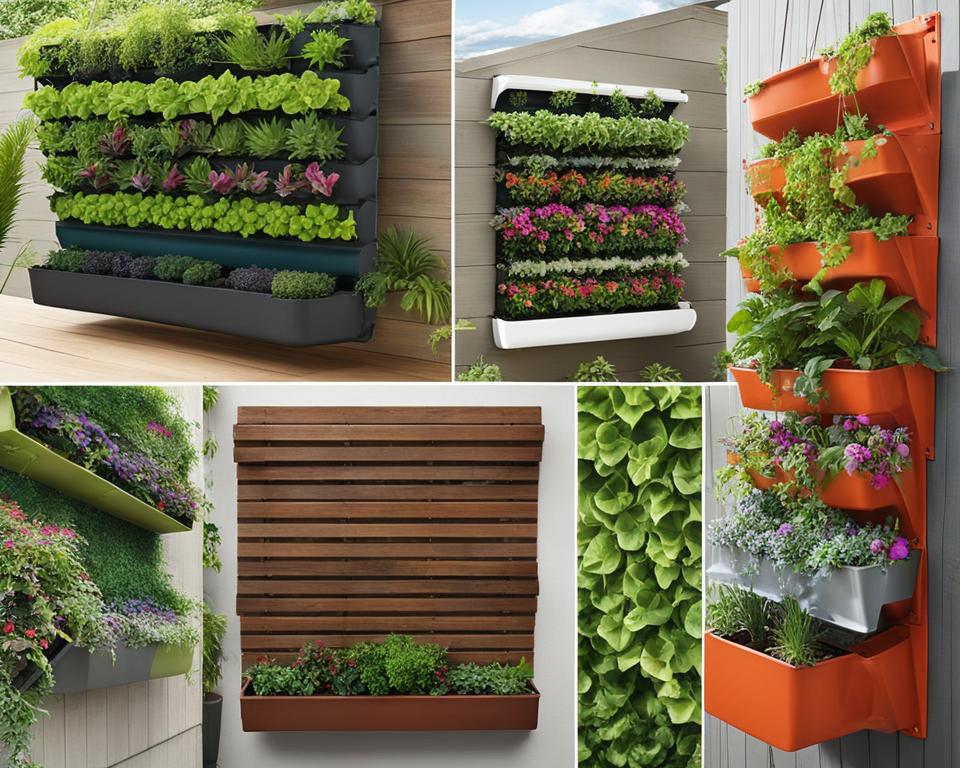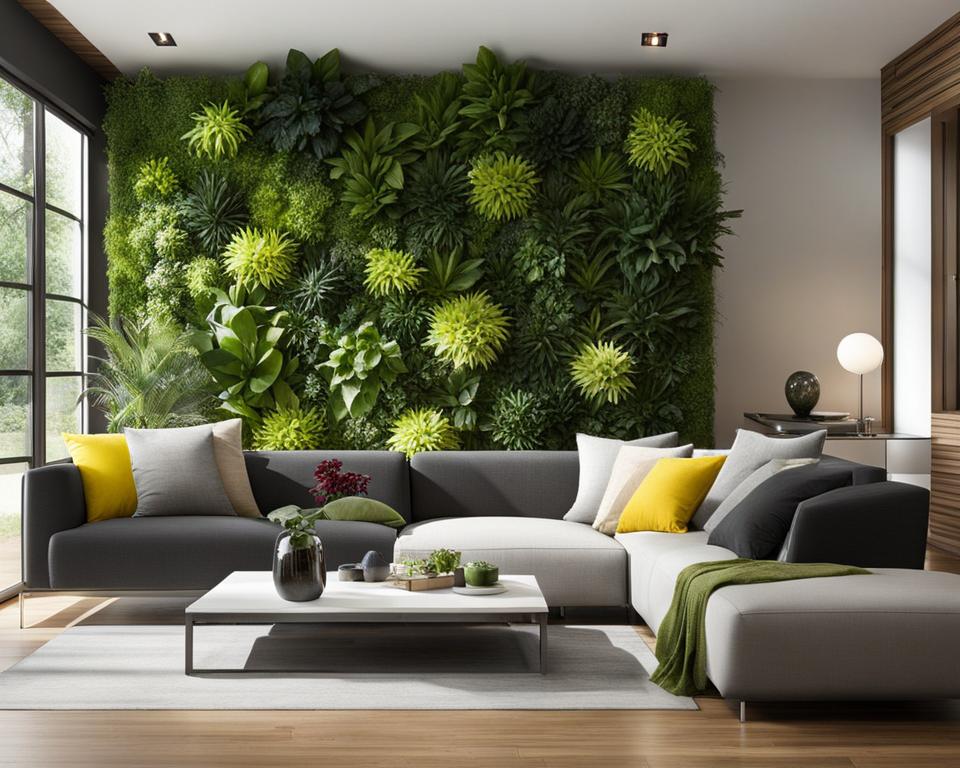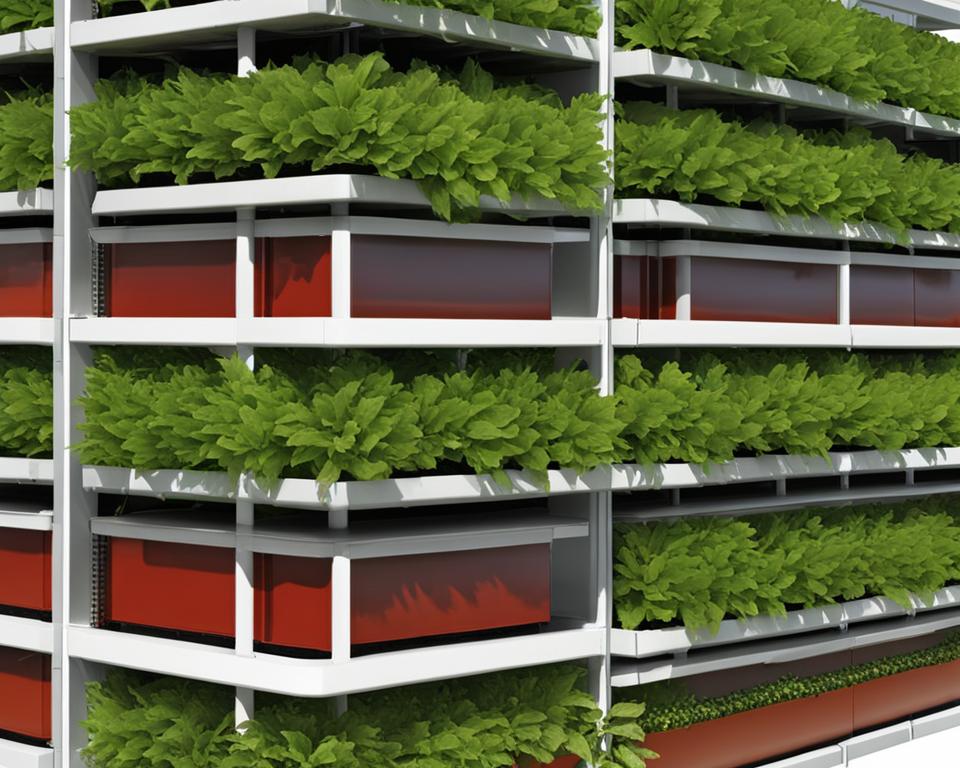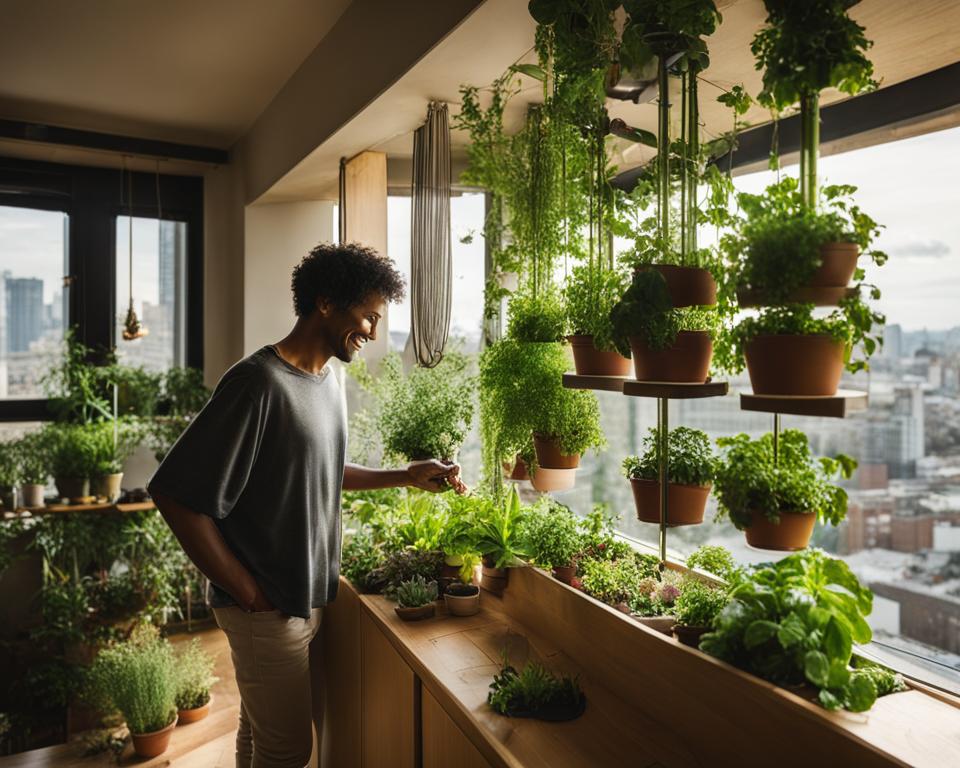In this article, I will share everything you need to know about vertical gardening systems. Whether you have limited outdoor space or simply want to keep your plants close to home, vertical gardening is the perfect solution. Discover the beauty and benefits of creating a green oasis in your own space with these DIY tips and valuable advice.
Key Takeaways:
- Vertical gardening systems are a versatile and practical solution for limited spaces.
- DIY vertical gardening allows you to create a green oasis in your own space.
- Vertical gardening tips can help you maximize your space and plant selection.
- Bring beauty and nature into your home with indoor vertical gardening.
- Investing in a vertical garden kit can make vertical gardening even easier.
What is a Vertical Garden?
A vertical garden is a creative and innovative way of growing plants vertically, utilizing various frameworks such as pots, trays, or even breathable socks. This approach not only maximizes limited space but also adds a touch of natural beauty to any environment. With numerous vertical garden ideas and designs available, you can create a stunning green oasis that suits your personal style and space.
Vertical gardens are versatile and can be implemented in both indoor and outdoor settings. They offer a unique way to showcase your favorite plants and add a decorative element to any space. Whether you have a small balcony, a backyard, or even a living room wall, there are endless possibilities to explore when it comes to vertical garden designs.
“Vertical gardens are not only practical but also aesthetically pleasing. They allow you to create your own mini green wall, adding a touch of nature to urban environments.” – Gardening Expert
So, whether you want to bring a breath of fresh air into your apartment or create a stunning focal point in your garden, vertical gardening is worth considering. The possibilities for vertical garden ideas and designs are endless, allowing you to unleash your creativity and transform any space into a lush and vibrant oasis.
| Vertical Garden Ideas | Vertical Garden Designs |
|---|---|
| Create a hanging herb garden using small pots. | Install a living wall with a variety of plants. |
| Design a vertical succulent garden using a wooden frame. | Construct a vertical garden with built-in water irrigation. |
| Grow vertical vegetables using trellises or cages. | Use repurposed materials like old ladders or pallets as planters. |
Why You Should Consider Vertical Gardening

Vertical gardening is a practical and versatile solution for both indoor and outdoor spaces. Whether you have limited growing space or simply want to create a beautiful green display, vertical gardening offers numerous benefits. Here are a few reasons why you should consider incorporating vertical gardening into your gardening routine:
- Maximize Space: Vertical gardening allows you to make the most of your available space. By growing plants vertically, you can utilize walls, fences, or even hanging structures to create a lush garden without taking up valuable ground space.
- Easy Access to Fresh Herbs and Greens: With vertical gardening, you can have fresh herbs and greens right at your fingertips. Having these culinary essentials within reach makes it convenient to add a burst of flavor to your dishes and enjoy the freshness of homegrown produce.
- Reduce Weed Pressure and Pests: When plants are grown vertically, they are less susceptible to weeds and pests. The elevation helps to minimize weed growth, while the vertical structure makes it more challenging for pests to access your plants.
Furthermore, vertical gardening adds ambiance, decor, and privacy to your outdoor space. It can transform a plain wall or fence into a lush green backdrop that enhances the overall aesthetic appeal of your garden.
When it comes to the types of plants that can be grown vertically, the possibilities are endless. You can cultivate a variety of flowers, herbs, vegetables, and even fruits. Some popular options for vertical gardening include tomatoes, strawberries, lettuce, and various trailing vines.
Whether you choose to embark on an indoor or outdoor vertical gardening journey, the benefits are undeniable. It’s a great way to maximize space, enjoy fresh produce, and create a visually stunning garden that adds life to any environment.
Vertical Garden Plants
| Plant | Sunlight Requirements | Watering Needs |
|---|---|---|
| Tomatoes | Full sun | Regular watering |
| Strawberries | Full sun to partial shade | Regular watering |
| Lettuce | Partial shade | Regular watering |
| Trailing Vines (e.g., Pothos) | Indirect to bright light | Minimal watering |
Types of Vertical Garden Kits

When it comes to vertical gardening, there are various types of vertical garden kits available that can help you create a stunning and functional green space. These kits make vertical gardening easy and convenient, whether you’re a beginner or an experienced gardener. Let’s explore some of the best vertical garden systems and techniques.
Wall Vertical Garden Kits
Wall vertical garden kits are a popular choice for many gardeners due to their functionality and aesthetic appeal. These kits are designed to be mounted on walls or fences, allowing you to create a vertical garden in any outdoor space. They come in a variety of styles and sizes, and some even offer the flexibility of being free-standing. With wall vertical garden kits, all plants have access to sunlight simultaneously, ensuring optimal growth.
Circular Vertical Garden Kits
If you’re looking for a versatile and easy-to-set-up vertical garden, consider circular vertical garden kits. These kits can be placed anywhere, whether it’s your backyard, balcony, or patio. They are designed in a circular shape, allowing you to grow a variety of plants in a compact space. However, it’s important to note that circular vertical garden kits require frequent rotation to ensure all plants receive adequate sunlight. So, if you’re willing to put in a little extra effort, these kits can be a great option for your vertical gardening needs.
When choosing a vertical garden kit, it’s important to consider factors such as the materials used, stability in windy areas, and the design of the planting holes. Each kit has its own unique features and benefits, so take some time to research and find the best vertical garden system that suits your needs and preferences.
| Vertical Garden Kit | Features |
|---|---|
| Wall Vertical Garden Kits | – Can be mounted on walls or fences |
| – Provides simultaneous access to sunlight for all plants | |
| Circular Vertical Garden Kits | – Versatile and easy to set up |
| – Requires frequent rotation for adequate sunlight |
Wall Vertical Garden Kits

Wall vertical garden kits are a popular choice for many gardeners due to their functionality and aesthetic appeal. These kits allow all plants to have access to sunlight simultaneously, and some can be permanently secured to walls or fences. They are versatile and can be free-standing if desired. When choosing a wall vertical garden kit, consider the materials used, the size of the planting holes, and the overall design.
Choosing the Right Wall Vertical Garden Kit
When selecting a wall vertical garden kit, there are a few key factors to consider. Firstly, pay attention to the materials used in the kit’s construction. Look for durable and weather-resistant materials such as metal, plastic, or composite materials that can withstand the elements. This will ensure that your vertical garden remains sturdy and long-lasting.
Additionally, consider the size of the planting holes in the kit. Different plants have varying root systems and space requirements, so it’s important to ensure that the kit’s planting holes are suitable for the types of plants you plan to grow. Some kits may have adjustable planting hole sizes, allowing for more flexibility in plant selection.
The overall design of the wall vertical garden kit is also crucial. Look for a kit that is easy to assemble and install, with clear instructions provided. Some kits may offer customization options, allowing you to arrange the planting pockets in different configurations to suit your space and design preferences.
| Advantages | Disadvantages |
|---|---|
|
|
Wall vertical garden kits offer a convenient and space-saving way to create a vibrant green display. With careful consideration of the materials, planting hole sizes, and overall design, you can find the perfect wall vertical garden kit to bring life and beauty to your walls or fences.
Circular Vertical Garden Kits
Bring a unique touch to your vertical garden
When it comes to vertical gardening, circular vertical garden kits offer an interesting and eye-catching alternative. These kits are designed to create a visually stunning display of plants arranged in a circular pattern. With their innovative design, circular vertical garden kits can be a focal point in any garden or outdoor space.
One of the advantages of circular vertical garden kits is their versatility. They can be easily placed in various locations, such as patios, balconies, or even indoors. Their compact size makes them suitable for smaller spaces, while still allowing you to grow a significant number of plants.
It is important to consider the materials used in these kits, as well as their stability. Look for kits made from durable materials that can withstand outdoor conditions. Additionally, choose a kit that provides adequate drainage to prevent waterlogged roots and promote healthy plant growth.
With the right selection of plants and careful arrangement, a circular vertical garden kit can be a stunning addition to your outdoor or indoor space. Whether you prefer a vibrant mix of colorful flowers or a selection of fresh herbs for your kitchen, the circular design of these kits allows you to create a unique and personalized vertical garden.
“Circular vertical garden kits offer an innovative and aesthetically pleasing way to bring nature into your space.” – Gardening Enthusiast
Soil-based vs Hydroponic Systems

When it comes to vertical gardening techniques, choosing the right system is crucial for the success of your garden. Two popular options to consider are soil-based and hydroponic systems. Each has its own advantages and considerations, so let’s take a closer look at both.
Soil-based Systems
Soil-based systems use traditional soil as the growing medium. This allows plants to access essential nutrients and a diverse microbiome, promoting healthy growth. Soil-based vertical gardens are versatile and can accommodate a wide range of plant species. They provide a more natural growing environment and are easier to maintain in terms of watering and fertilizing.
“Soil-based vertical gardens provide plants with a familiar growing medium, allowing them to thrive naturally.”
Hydroponic Systems
Hydroponic systems, on the other hand, use a soilless growing medium and rely on a steady supply of water and nutrients. This method allows for precise control over plant nutrition and reduces the risk of soil-borne diseases. Hydroponic vertical gardens are space-efficient and can be set up indoors or outdoors. They require less water and are easier to manage in terms of pest control.
“Hydroponic vertical gardens offer precise control over plant nutrition and are ideal for limited space.”
While both systems have their merits, soil-based systems are considered the best vertical garden systems for overall plant growth and resilience. The natural properties of soil support a robust root system and provide a stable environment for plants to thrive. However, hydroponic systems can be a great alternative if space is limited or if you prefer the controlled environment they offer.
| Soil-based Systems | Hydroponic Systems |
|---|---|
| Uses traditional soil as the growing medium | Relies on a soilless growing medium |
| Provides plants with essential nutrients and a diverse microbiome | Allows precise control over plant nutrition |
| Accommodates a wide range of plant species | Space-efficient and can be set up indoors or outdoors |
| More natural growing environment | Reduced risk of soil-borne diseases |
| Easier to maintain in terms of watering and fertilizing | Requires less water and easier to manage pest control |
Choosing between soil-based and hydroponic systems ultimately depends on your space, preferences, and the specific plants you want to grow. Both options offer unique benefits and can help you create a beautiful and thriving vertical garden.
Creating an Indoor Vertical Garden
Indoor vertical gardening is a wonderful way to bring nature’s beauty into your home. With a little planning and creativity, you can create a vibrant green oasis that adds life and freshness to any room. When designing your indoor vertical garden, consider the location and available natural light. South-facing walls often receive the most sunlight and are ideal for light-loving plants.
Choose suitable plant species that can thrive in indoor environments. Some popular choices include pothos, spider plants, and peace lilies. These plants are known for their resilience and ability to thrive in low-light conditions. Make sure to provide proper watering and drainage systems to keep your plants healthy. Overwatering can lead to root rot, so it’s important to find the right balance.
Adequate light optimization is essential for maintaining a healthy indoor vertical garden. Consider using grow lights to supplement natural light and ensure that your plants receive the necessary amount of brightness. Regular monitoring and pruning will also help to keep your indoor vertical garden looking its best.
“Bringing nature indoors not only adds beauty to your space but also offers numerous health benefits. Indoor plants can improve air quality, reduce stress, and increase productivity. So why not create your own indoor vertical garden and enjoy all the positive effects it has to offer?”
Conclusion
Vertical gardening systems offer a versatile and practical solution for those with limited space or a desire to create a green oasis. With the right knowledge and tools, anyone can master the art of vertical gardening. Whether you choose to go DIY or invest in a vertical garden kit, the possibilities are endless.
By implementing vertical gardening techniques, you can transform any space into a lush and vibrant environment. Vertical gardens not only maximize your growing potential in a small footprint, but they also provide easy access to fresh herbs and greens for cooking. Additionally, vertical gardening reduces weed pressure and pests while adding ambiance, decor, and privacy to your outdoor or indoor space.
So why wait? Start greening your space today and enjoy the beauty and benefits of a vertical garden. Whether you have a balcony, a small backyard, or even just a sunny wall, vertical gardening systems allow you to bring nature closer to you. Embrace the endless possibilities and create your own green oasis.
FAQ
What is vertical gardening?
Vertical gardening is a method of growing plants vertically, using frameworks such as pots, trays, or breathable socks.
Why should I consider vertical gardening?
Vertical gardening is an excellent option for those with limited growing space, provides easy access to herbs and greens, reduces weed pressure and pests, and adds ambiance and privacy to your outdoor space.
What types of vertical garden kits are available?
There are various vertical garden kits available, including wall vertical garden kits and circular vertical garden kits.
What are wall vertical garden kits?
Wall vertical garden kits are versatile systems that can be permanently secured to walls or fences, allowing plants to have access to sunlight simultaneously.
What are circular vertical garden kits?
Circular vertical garden kits are simple to set up and can be placed anywhere, but require frequent rotation to ensure all plants have access to sunlight.
What are the differences between soil-based and hydroponic systems?
Soil-based systems use traditional soil, while hydroponic systems use a soilless growing medium and rely on a steady water supply.
How do I create an indoor vertical garden?
When creating an indoor vertical garden, consider the location, available natural light, suitable plant species, watering and drainage systems, and regular maintenance.

